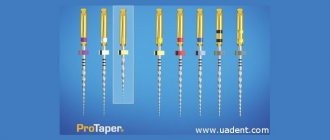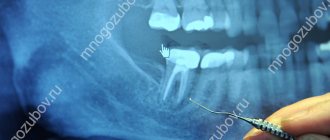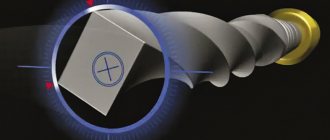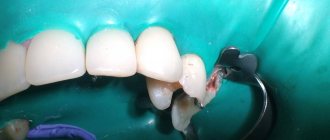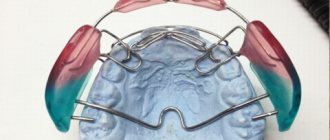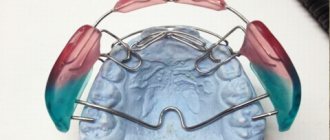The new nickel titanium ProTaper represent a revolutionary advancement in the field of root canal treatment. ProTaper files were designed specifically to meet certain criteria - they must have superior flexibility, unparalleled efficiency and high security. The unique design features of ProTaper allow clinicians to more consistently create a smooth, tapered shape in highly curved canals and canals with anatomical challenges.
Protapers are a new version of the world's most popular endodontic nickel titanium instrument system, meeting the requirements of all dentists in all clinical situations.
Protapers are unique, ultra-flexible nickel-titanium files of a new generation that allow high-quality preparation of difficult root canals that are difficult to traditional instrumentation.
Composition: the cutting part of these tools is made of nickel-titanium alloy.
Nickel-titanium instruments should not be used to remove polymer pastes from root canals.
ADVANTAGES OF UNIVERSAL PROTAPERS
+ Easier
- uniform sequence of instruments regardless of the shape of the root canal
- simply remember the application protocol (color coding)
- Root canal drying and obturation products are specially designed to work with the ProTaper system and are color coded
+ Faster
- in most cases only 3 tools are needed
- high cutting efficiency
+ More efficient
- increased apical taper for better root canal preparation
- Better removal of dentinal debris thanks to the unique “multiple taper” of the instruments
+ Safer
- rounded guide tip minimizes the likelihood of deviation from the channel
- There is a manual version of instruments for anatomically complex clinical situations, as well as for clinicians who prefer to use manual instruments due to better tactile control
Introduction
The new NiTi rotating ProTaper files revolutionize root canal preparation.3 They are specially designed to provide good flexibility, efficiency and significantly greater safety. The unique design features of ProTaper files allow clinicians to create uniformly tapered shapes over and over again in anatomically difficult or highly curved canals (Figures 1 and 2). The kit consists of just six (6) easy-to-use files, a series of three 'shaping' and three 'finishing' tools, currently available in two sizes: 21mm and 25mm (Figure 3). The following section describes the geometry of the ProTaper.
Picture 1
The anatomically challenging maxillary second premolar has an additional pulp shelf, and three canals are carefully processed with ProTaper files. (Property of Dr. Philip Lumley; Birmingham, England)
Figure 2
The significantly curved and split canals of the mandibular second molar were gracefully shaped using ProTaper files. (Property of Dr. Elio Berutti; Torino, Italy)
Figure 3
The ProTaper system revolutionizes endodontic preparation because it consists of only three forming files and three finishing files.
PROTAPERS F1 PROTAPERS F2 PROTAPERS F3
Finishers are designed to finalize the apical third of the root canal, as well as to level and widen the middle third of the canals. They, like shapers, include 3 tools: F1, F2, F3.
The tip diameter of the F1 pro taper is 0.20 mm, F2 0.25, F3 0.30. It is characteristic that all 3 tools in the interval D0-D3 have a fixed taper (.07, .08, .09%, respectively). After D3, although the tool diameter continues to increase, the taper decreases to 0.055, thereby increasing the flexibility of the prop taper.
1. Indications for use: Protapers are intended for use only in a clinical setting by specially trained specialists. Scope of application: formation and cleaning of the root canal system.
2. Contraindications: Not known.
3. Warnings: None known.
4. Precautions:
- Repeated disinfection cycles and sterilization increase the risk of file fracture.
- These instruments should not be immersed in sodium hypochlorite solution.
- Cleaning of Instruments: Strictly follow the cleaning instructions recommended by the manufacturer.
- Irrigate generously and frequently.
- Create an adequate carpet runner using hand files up to a minimum of ISO size 15.
- Use the instruments at a constant rotation speed of 150 – 350 rpm with light apical pressure.
- Clean the tool grooves as often as possible and inspect the file for signs of deformation or wear.
- For optimal performance, it is recommended to use torque-controlled devices.
- Use the shaping files (S1, S2 and Sx), working in separate sweeping movements to create a straight-line approach to the root canal.
- Use finishing files (F1, F2, F3, F4 and F5) without using sweeping motions.
- Use appropriate finishing files to “passively” pass the entire working length of the canal and, once reached, immediately remove the instrument.
5. Adverse reactions: To date, no adverse reactions have been reported.
Main characteristics
Protapers have unique features that allow treatment of complex and atypical canals.
- Convex triangular cross section. This design increases the strength of the profile and reduces the contact area with the canal cavity, thereby making treatment safe and reliable.
- Multiple tapers increase tool flexibility and efficiency.
- Varying angles and pitches of spirals. This feature allows you to clean the cavity as efficiently as possible, reducing the risk of clogging.
- Progressive taper. This design increases the flexibility and cutting ability of the file, thereby reducing the time for canal processing, as well as increasing the safety of the manipulations.
PROTAPERS - STEP-BY-STEP INSTRUCTIONS FOR USE
- Create direct access to the root canal orifice.
- Constantly irrigate and check the patency of the carpet with an ISO 15 size hand file.
- Usage protocol:
- Locate the mouth.
- Passively use an ISO size 15 hand file until you feel resistance.
- Use the S1 shaping file, working in a sweeping motion until you reach the penetration depth of an ISO size 15 hand file.
- Repeat this sequence until you have determined the working length using an ISO size 15 hand file and have gone through the entire working length of the canal using the S1 tool.
- Use the S2 shaping file, working in a sweeping motion until you reach working length.
- Confirm the working length.
- Use the F1 finishing file (without sweeping movements), moving it deeper with each insertion until you reach working length.
- Calibrate the apical foramen using hand files.
- Use the appropriate finishing file (F2, F3, F4, F5) without sweeping movements to the full working length if additional expansion is needed or if the apical foramen is larger. If necessary, use Sx sweeping movements to remove ostial dentin and/or to create a wider coronal portion of the canal.
Protaper Universal - video, operating method
6. Disinfection, cleaning and sterilization: Clean the instruments and stand first. Then sterilize the instruments in the bags using an autoclave at 134ºC, 3 bar pressure for 18 minutes.
6.1 General recommendations
- Tools marked "disposable" are not intended to be reused.
- The user is responsible for the sterility of the product upon first use and each subsequent use, as well as for the use of damaged or contaminated instruments.
- For your own safety, please use personal protective equipment (gloves, goggles).
- Use disinfectant solutions with proven effectiveness (listed by the German Society for Hygiene and Microbiology; CE marked; approved by the German Inspectorate for Hygiene and Microbiology).
- quality of food products and medicines).
- Tungsten carbide burs, plastic stand, hand tools and nickel - titanium tools are destroyed by hydrogen peroxide (H2O2) solution.
- Nickel-titanium instruments are destroyed when immersed in a NaOCl solution for more than 5 minutes with a concentration of more than 5%.
- Aluminum instruments are destroyed in a solution of caustic soda with mercury salts.
- Do not use acidic (pH < 6) or alkaline (pH > solutions.
- After 5 processing cycles, markings may be destroyed
conclusions
This article described the geometry, properties and advantages of ProTapers. The basic principles of their use were also discussed. Our main goal is to help clinicians understand the benefits of this innovative yet easy-to-use toolkit.
The ProTaper rotating file system, introduced over the past few years, is the fruit of the joint efforts of Drs Ben Jonson, Pierre Mastu, Clifford Ruddle and John West, as well as engineers François Haebou and Gilbert Roth (Densplay Maillefer, Balague, Switzerland). Dr Ruddle would like to thank everyone involved in this project for their assistance.
REFERENCES 1. K.J. Ruddle: "Nickel-Titanium Rotary Systems: A Review of Existing Instruments and Geometries," Dentistry Today 19:10, pp. 86-95, 2000. 2. K.J. Ruddle: “Modern concepts in root canal preparation,” Dentistry Today 20:2, pp. 76-83, 2001. 3. J.D. West: "Introducing a New Rotating Endodontic System: Progressive Taper Files," Dentistry Today 20:5, pp. 50-57, 2001. 4. H. Levine: "Access Cavities," Dental Clinic of North America, pp. 701-710, November 1967. 5. H. Schilder: “Cleaning and shaping the root canal system,” Dental Clinic of North America, 18:2, pp. 269-296, 1974. 6. K.J. Ruddle: “Endodontic canal preparation: revolutionary strategies for cleaning and shaping,” Dentistry Today 13:2, pp. 44-49, 1994. 7. P. Mast: “Endodontics - a clinical guide.” Paris: SDP publication, 1993. 8. E. Berutti, R. Marini: “Evaluation using a scanning electron microscope of the cleaning ability of sodium hypochlorite at different temperatures,” J Endod 22:9, pp. 467-470, 1996. 9. E. Berutti, R. Marini, A. Angeretti: “Penetration ability of various irrigants into dentinal tubules,” J Endod 23:12, pp. 725-727, 1997. 10. K.J. Ruddle: “Chapter 8, Cleaning and Shaping Root Canal Systems. In Cohen S, Burns RS, editors: Pulp Paths, pp. 231-291, 8th ed., Mosby, St. Louis, 2001. 11. M.J. Scianamblo: Chapter 15, “Preparation of Endodontic Cavities.” "Endodontics", pp. 374-391, Castellucci, Edizione Odontoiatrice Tl Tridente, Prato, Italy, 1993. 12. K.J. Ruddle: “Chapter 25, “Nonsurgical Endodontic Treatment Revision.” In Cohen S, Burns RS, editors: Pathways of the Pulp, pp. 875-929, 8th ed., Mosby, St. Louis, 2001. 13. Pineda F, Cuttler W: Mesial-distal and buccal -lingual x-ray study of 7275 root canals,” Oral Surgery 33:101, 1972. 14. S. Shabagarg, V.V.U. Guun, A.H. Gluskin: “Laboratory evaluation of the Root ZX electronic apex locator,” J Endod 22:11, pp. 616-618, 1996. 15. Results of a study of leading endodontists from North America, South America, Asia and Eastern Europe. Regional meetings in 2000 and 200.
PROTAPERS - RE-TREATMENT
D1+D2+D3: instruments specially designed for simple filling of root canals:
- the D1 instrument has an active tip, facilitating initial penetration into the root canal
- instruments have different lengths and taper of the working part for working in different parts of the root canal (coronal/middle/apical)
The sequence of using the tools is easy to remember
- From shortest to longest tool: D1 – D2 – D3
Easy identification
- dark gray handles no more than 11 mm long for better visibility
- instruments have one, two or three white rings respectively
How to choose the right one
Each dentist chooses a prop taper model, focusing on ease of use and the methodology of their work. This is an individual tool, so there is no universal selection algorithm.
But since this is a relatively expensive device (the cost of one set of 6 files costs approximately 2000 rubles), it is important not to buy a fake. Its signs will be:
- the working part is matte (high-quality files are polished to a mirror finish);
- the color marking is glossy, the paint is unevenly distributed over the colored part;
- the file is curved;
- the working part of the propaper is visually different from the original, has chips or other defects;
- the price is significantly lower than usual;
- no marking stripes;
- packaging differs in appearance or quality.
The appearance of the packaging does not always indicate a fake. You can call the manufacturer's hotline and find out if the design has changed.
The original packaging must have a holographic sticker.
PROTAPER D3 – FOR THE APICAAL PART OF THE CANAL
Rules for using ProTaper instruments to remove filling material from root canals
- instruments are inserted into the canal by applying light pressure in the apical direction
- regularly remove the instrument from the canal, check its working part and clean it
- if the instrument does not advance deeper, use a hand instrument to overcome resistance and confirm patency of the canal
Recommended speed:
- for removing gutta-percha or Thermafil/ProTaper® obturators: 500 – 700 rpm
- for removing pastes based on zinc oxide and eugenol: 250 – 300 rpm
You can buy ProTaper (ProTaper) machine S1, 25 mm, Dentsply, for the treatment of complex cases, blister (6 pcs) produced by Dentsply at ExDent.ru at a price of 3,500 rubles.
Advantages and disadvantages
Modern prop tapers have many advantages: they are durable, easy to use, and highly effective. In addition to these qualities, they have additional advantages that make the doctor’s work easier:
- To completely clean the canal, 3 to 6 propapers are required - the operating time is reduced;
- due to its shape, dentine filings are instantly cleaned when removing the instrument;
- each item has its own color coding, so the doctor will not confuse the sequence of devices during treatment;
- the likelihood of tooth damage when the tool deviates from the trajectory is reduced;
- Suitable for processing rounded channels.
At the same time, propapers have a number of disadvantages that limit their use:
- the length of the processed channel should not exceed 31 mm, because there are no longer pro-tapers;
- channel width – up to 0.3 mm (up to 30 pro taper size);
- they do not have systems to prevent obstruction (blockage) of the canal.
Protapers require careful handling and compliance with the instructions prescribed by the manufacturer. Otherwise, you won't be able to reuse the tool. It can only be used by a dentist who has undergone preliminary training.
About the group of initiating (forming) files
The purpose of the group (passing the root canal and giving it the necessary configuration) determines the design features of the files included in it.
The main shaping shapers (No. 1 and 2, or S1 and S2) have the following characteristics:
- cutting part length 21 or 25 mm;
- diameters D0 equal to 0.17 and 0.20 mm, respectively;
- maximum recess diameters, in D14 approaching 1.20 mm;
- with a modified guide apical cone, they have a progressively increasing blade taper, allowing each file to prepare only a specific required area.
For the auxiliary shaper Sx (or X), which serves as a device for working out short root canals, to recognize the direction and form a convenient configuration of long canals in their coronal zone, 9 levels of taper are provided (from 3.5 to 19%) for ease of cutting tissues with back-cleaning movements with segment D6 - D9.
Moreover, the increase in taper from D1 to D9 (from .035 to .19) is replaced by its subsequent decrease (to .02). The shaper features a gold-painted handle without an identifying ring.
For file No. 1 (with an increase in taper from .02 to .11) this is the development of the coronal third of the canal, for file No. 2 (with an increase in taper from 0.04 to 0.115 in D16) - expansion and preparation of its middle third. While both protapers optimize the configuration of the two-thirds of the coronal fragment of the canal, they also serve to progressively expand its apical third.
The instruments are easily recognizable thanks to the handles with respectively purple and white rings on them.
For manual work
Manual protapers are applicable for the same manipulations as machine ones and have the same alphanumeric designation.
The standard set includes 6 tools with handles of different colors in accordance with their technical data:
- Sx – with orange;
- S1 – with violet;
- S2 – with white;
- F1 – with yellow;
- F2 – from red;
- F3 – with blue.
Protaper S2
The manual ProTaper Sx is available in one modification - 19 mm, the length of the active zone of instruments S1, S2, F1, F2, F3 - 25 or 31 mm.
Hand files F4 (with black handle) and F5 (with black and yellow) with an active area length of 25 mm are intended for both initial and final work on root canals.
